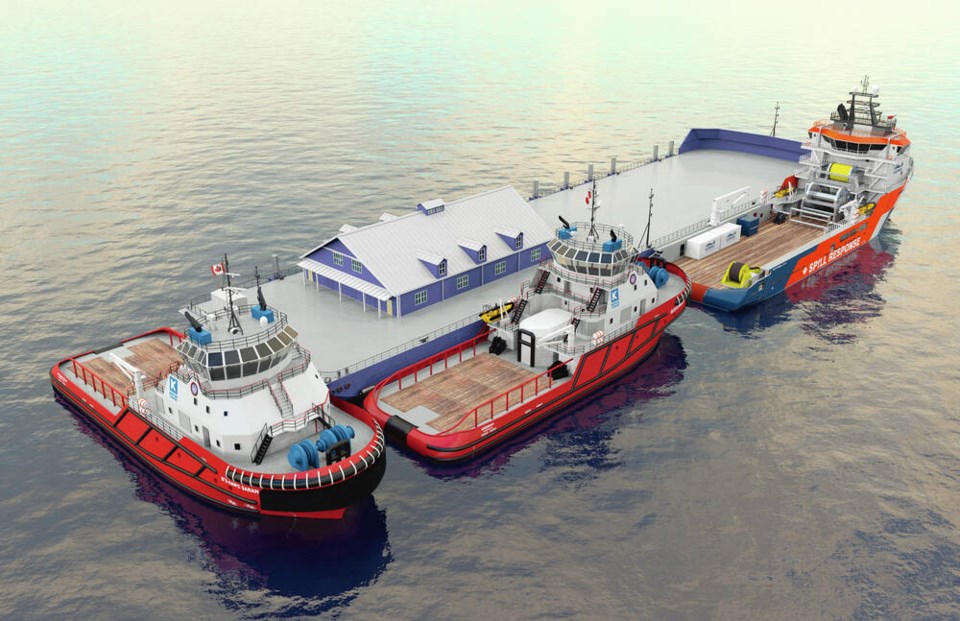Tugboats based on the Island’s southwest coast will be the exclusive escort providers in the region for tankers carrying oil from the expanded Trans Mountain pipeline under a new 15-year deal.
Trans Mountain said Kotug Canada tugboats, to be based at Beecher Bay, will escort tankers between the outer boundary of the Port of Vancouver to the western entrance of Juan de Fuca Strait.
As many as four tugboats accompany tankers through Vancouver’s harbour, while others escort the vessels from Saturna Island to beyond Victoria.
Regulations also require two pilots to be in command of tankers on their way in and out of Vancouver. Inbound tankers pick up pilots just off Victoria to bring the vessel into the terminal at Burrard Inlet.
In a separate deal with the Western Canada Marine Response Corporation, which is responsible for dealing with oil spills around Vancouver Island, the Strait of Georgia and Metro Vancouver’s coastline, Kotug will also supply and operate a dedicated offshore supply vessel equipped for oil spill response.
All three vessels — the two 150-foot escort tugs and the 245-foot offshore supply vessel — will be moored at a barge floating just beyond Beecher Bay’s marina.
Michael Lowry, of Western Canada Marine Response, said the deal fleshes out plans to establish an emergency response base at Beecher Bay, one of six to be established or augmented as part of a $163-million expansion of disaster response on the West Coast.
Lowry said Kotug will operate the offshore vessel under direction from Western Canada Marine Response and with staff who specialize in oil spill response.
“These tugs will bring significant new tow capability to the region and will raise the level of marine safety and emergency response, benefiting the shared waters of the Salish Sea,” said Ian Anderson, chief executive of Trans Mountain.
Sc’ianew First Nation Chief Russ Chipps and his community “have shown great leadership in the protection of the marine environment, and this partnership will provide significant employment and commercial opportunities,” he said.
“This is a great example of how shared values of protecting the marine environment, building capacity and growing local economies can work together.”
Kotug’s deal with Sc’ianew First Nation will support its economic activities and provide training and employment, while the company expects to get direction and insight on how to operate in the coastal environment.
“We have gone through great lengths, controversy and criticism to protect the ocean,” said Chipps. “This is just one part of our commitment to our people to do so. We want to be the centre for research, development and ocean protection, all while being the ambulance of the sea.”
The offshore supply vessel will be equipped with 4,000 feet of offshore boom, a high-speed sweep system and a high-capacity skimming system and have overnight accommodation space for 26 crew.
The vessel allows Western Canada Marine Response to mount a large-scale response within six hours anywhere along the shipping lanes.
Lowry said the barge and vessels are expected to be established at Beecher Bay before the end of 2022, when all six bases are expected to be equipped and operational.
Bases at Port Alberni and the Fraser River are already complete, while Sidney and Nanaimo should be finished by the end of the month.
The expansion program, which has seen its budget grow from $150 million in 2019 to $163 million, will also add 44 vessels ready for spill response and the hiring of 137 people.
Only 34 vessels have been delivered so far. The others are still being built.
Trans Mountain would not update when it expected the expanded pipeline to be in service. This year, it suggested it could be operational by the end of 2022.
Traffic is expected to grow to about 34 tankers per month as a result of the project.



